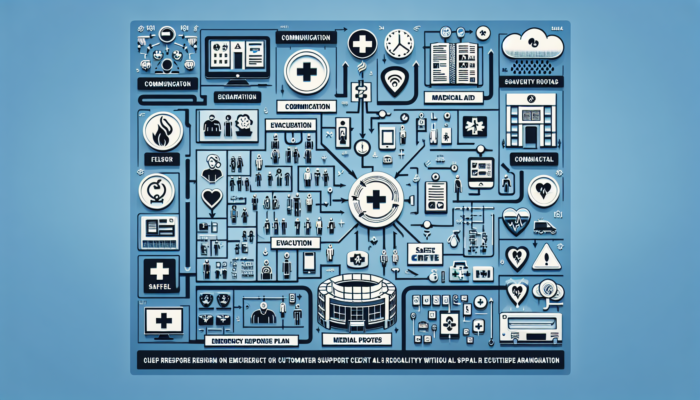Emergency Response Management in Customer Support Always Ready
In today’s rapidly evolving and unpredictable landscape, businesses must equip themselves to tackle any unforeseen challenges that may disrupt their operations, particularly regarding customer support. Emergencies can emerge unexpectedly, whether they are a result of natural disasters, cyber attacks, or global pandemics. Consequently, establishing a robust emergency response management plan is essential for ensuring operational continuity and delivering outstanding customer support, even amidst adversity.
Why Emergency Response Management is Critical for Business Resilience
Emergency response management encompasses the systematic process of recognising potential risks, formulating strategies to mitigate them, and executing effective responses during emergencies. Specifically within the realm of customer support, this involves meticulous planning and the organisation of resources to guarantee uninterrupted service delivery and maintain customer satisfaction even in times of crisis.
Implementing a robust emergency response management system is vital for several key reasons:
- Preserving Customer Trust: During times of crisis, customers are likely to experience increased anxiety and uncertainty. By showcasing preparedness and an efficient response mechanism, businesses can foster confidence among their customers, thereby solidifying their trust.
- Reducing Downtime: Interruptions in customer support can lead to dire repercussions, including lost sales opportunities, diminished customer loyalty, and a tarnished reputation. A meticulously crafted emergency response plan serves to minimise downtime, ensuring that customer queries and concerns are addressed without delay.
- Prioritising Employee Safety and Well-being: A comprehensive emergency response management plan prioritises the safety and welfare of customer support personnel. By providing clear guidelines and protocols, businesses can ensure that their employees are well-prepared to manage emergencies while safeguarding their own safety.
Essential Elements of a Comprehensive Emergency Response Management Plan

Formulating an emergency response management plan that caters specifically to the unique needs of your organisation is imperative. Although the specifics may differ by industry, the following components are typically essential for effective emergency response within customer support:
1. Comprehensive Risk Assessment and Analysis
To develop a thorough emergency response management plan, it is paramount to first identify potential risks and vulnerabilities that could adversely affect your customer support operations. This analysis should encompass both internal factors, such as technology failures and staffing shortages, as well as external threats, including natural disasters and cyber threats. Conducting a detailed risk assessment will help ascertain the likelihood and potential impact of each identified risk.
2. Thorough Emergency Preparedness Training
Once potential risks are identified, it is crucial to ensure that all members of the customer support team undergo extensive training on emergency protocols and procedures. This training should encompass a variety of scenarios, equipping employees with the essential skills to handle emergencies proficiently. Regular drills and simulations can further reinforce the training, ensuring that all personnel are adequately prepared.
3. Effective Communication Strategy

Establishing a transparent and efficient communication plan is vital for a successful emergency response within customer support. This strategy should outline protocols for notifying customers about service interruptions, providing timely updates on the situation, and directing them to alternative support options if necessary. Leveraging multiple communication channels, such as email, social media, and website notifications, is essential to effectively reach customers.
4. Implementation of Redundancy and Backup Systems
Incorporating redundancy measures and backup systems is crucial to ensuring that customer support operations continue seamlessly, even in the face of infrastructure failures or other disruptions. Consider investing in backup power sources, redundant network connections, and cloud-based customer support platforms. Regular testing and updates of these systems will help maintain their effectiveness and reliability.
5. Promoting Cross-Training and Strategic Resource Allocation
Encouraging cross-training among customer support personnel is essential for fostering flexibility and responsiveness during emergencies. By broadening individual skill sets, employees can manage various tasks and responsibilities as necessary. Furthermore, strategically allocating resources will enable the team to effectively address critical areas or high-priority customer inquiries during emergency situations.
6. Formal Incident Reporting and Analysis Process

Establishing a formalised process for documenting and analysing incidents that arise during emergencies is vital. This practice allows businesses to pinpoint areas requiring improvement, assess the effectiveness of their response measures, and implement necessary adjustments for future incidents. Regularly reviewing and updating the emergency response plan based on these evaluations is crucial for continual enhancement.
Adopting Best Practices for Enhanced Emergency Response Management
To bolster the effectiveness of your emergency response management approach, consider incorporating the following best practices:
- Regular Review and Updates of the Response Plan: Periodically assess and revise your emergency response plan to account for advancements in technology, personnel changes, or updates in operational processes. Keeping the plan current ensures that all employees are familiar with the latest protocols.
- Enhancing Collaboration and Coordination: Foster strong collaboration between customer support and other organisational departments. Coordinating efforts ensures a unified response during emergencies and facilitates the sharing of valuable insights and information.
- Continuous Training and Development: Promote ongoing training and education for customer support team members. Staying informed about emerging risks, industry trends, and best practices in emergency response management enables businesses to adapt their plans as required.
- Building External Partnerships: Forge partnerships or engage with external organisations that specialise in emergency response management. Their expertise, resources, and support during crises can significantly enhance your overall response capabilities.
- Regular Testing and Drills: Conduct routine drills and simulations to evaluate the effectiveness of your emergency response plan. These exercises help identify potential gaps or weaknesses and provide opportunities for necessary adjustments and enhancements.
The Necessity of Emergency Preparedness in Customer Support
In the realm of customer support, maintaining readiness for emergencies is a fundamental aspect of ensuring operational continuity, preserving customer satisfaction, and safeguarding your business’s reputation. By implementing a comprehensive emergency response management plan that encompasses risk assessment, training, communication strategies, and redundancy systems, businesses can navigate any storm and provide exceptional support to their customers, even in challenging times. Remember, preparation is paramount, and investing in emergency response management is synonymous with investing in the resilience and success of your organisation.
1. Why is emergency response management crucial for customer support?
Emergency response management is vital in customer support because it enables businesses to maintain customer trust, minimise downtime, and prioritise the safety and well-being of their employees. By preparing adequately for emergencies, businesses can instil confidence in their customers, address inquiries and issues swiftly, and ensure the safety of their customer support teams.
2. What are the fundamental components of an emergency response management plan in customer support?
The essential components of an emergency response management plan in customer support include:
- Risk assessment and analysis to pinpoint potential risks and vulnerabilities
- Emergency preparedness training to equip customer support teams with necessary skills
- Communication plan for notifying customers and providing updates
- Redundancy and backup systems to ensure continuous operations
3. What are the best practices for emergency response management within customer support?
The best practices for emergency response management in customer support encompass:
- Regularly reviewing and updating the emergency response plan
- Encouraging collaboration and coordination across departments
- Promoting continuous training and education for customer support teams
- Establishing partnerships with external organisations for additional support
- Conducting regular testing and drills to identify potential gaps or weaknesses
4. Why is continuous training and education essential in emergency response management?
Continuous training and education are critical in emergency response management as they empower customer support teams with updated knowledge about emerging risks, industry trends, and best practices. By staying informed, businesses can adapt their emergency response plans accordingly and enhance their overall readiness and response capabilities during emergencies.
Originally posted 2023-04-22 09:52:13.


